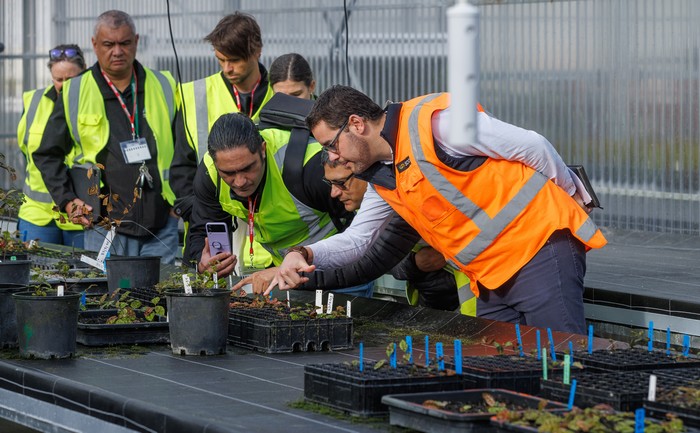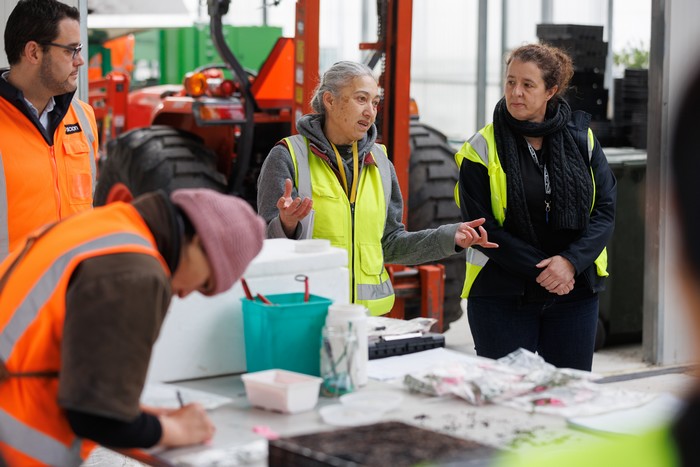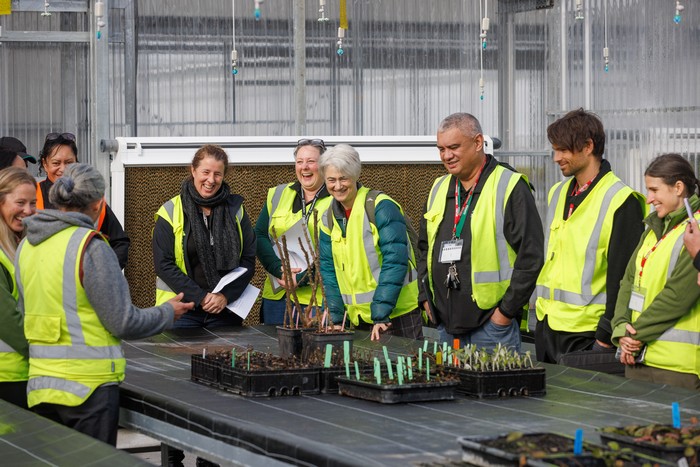Conservation efforts step up to protect native taonga at risk from myrtle rust
For immediate release
24 July 2023
Scientists and a Jobs for Nature team are on a race against time to save vulnerable native species under threat from myrtle rust in the Rotorua lakes area.
With fears mounting that species endemic to New Zealand could be wiped out by the fungal disease, researchers are urgently developing best practice methods for propagating plants from cuttings in the first stage of a long-term resistance breeding programme.
Scion forest pathologist Darryl Herron says myrtle rust’s spread had created a sense that conservation efforts are already at a critical stage.
“The population size of Lophomyrtus trees around the lakes area is quite small, and without any interventional management, we’re likely to lose them completely.
“With myrtle rust impacting these populations, we’ve realised how important it is to propagate cuttings before myrtle rust decimates them and we lose all access to their fruit or seeds in the future.”
The full impact of myrtle rust on the health of ramarama, rōhutu and their hybrids was revealed over spring and summer. This followed efforts to identify species populations around lakes Rotoiti, Rotomā and Okataina by the Scion-led Myrtle Rust Jobs for Resistance programme - Te Rātā Whakamaru last year.
The trees belong to the Lophomyrtus genus and are part of the myrtle family that is at risk from the infectious airborne fungus. Regular field visits confirmed the presence of myrtle rust in targeted populations and an overall decline in tree health.
Where myrtle rust was found, the Te Tira Rātā (field work team) identified parts of the tree that were most affected and how the disease was impacting its reproduction.

“The disease targets new leaf growth,” says Herron. “If a tree is constantly impacted by myrtle rust it will start to die back and eventually it will stop producing fruit or seeds that would usually fall to the ground. You’ll see fewer young saplings emerge and those that do are vulnerable to infection - that’s when you stop getting natural regeneration in the forest.”
Complicating conservation efforts have been high water levels at Lake Rotomā that have cut off access to some monitoring sites since February. With so many trees now under water, the team’s ability to take cuttings has also been restricted – a task that is critical for kickstarting a resistance breeding programme.
Te Rātā Whakamaru started in April 2022 and is delivered in partnership with Rotoiti 15 trust. It is funded by Jobs for Nature/ Mahi mō te Taiao through the Department of Conservation – Te Papa Atawhai.
With support from Scion scientists, 10 full-time staff have been trained as field technicians and are employed to carry out surveillance work in Bay of Plenty native forests and at Scion for three years. While during their first year they have focused on forests around the three lakes, surveying will be extended to other areas following engagement with hapū.
Engagement with mana whenua has been a core part of the programme so far. Before cuttings of ramarama, rōhutu and their hybrids could be removed from the field, Scion and Te Rātā Whakamaru sought permission from hapū and explained how cuttings could be used to preserve the genetic diversity of the local populations and breed for myrtle rust resistance.
Project technical lead Dr Jacqui Bond says that while the outlook for the species appeared dire, a positive has been the relationships built with mana whenua and the trust they have in the team to take cuttings.
“At the beginning of December, our team observed hundreds of flowers in the field but when we went back after Christmas there were no flowers and very little fruit development. We are not sure of the cause of this yet,” she says. “That’s one nail in the coffin of this species if you can’t get fruit to collect seed from.”
Hōmiromiro (field technician) Otaki Grant says the message received from mana whenua was clear. “They don’t want to idly stand by and watch the species decline. Their permissions for us to take cuttings have been pivotal in allowing the next phase of the project to begin for tree breeding.”

Rotoiti 15 Trust chairperson Arapeta Tahana says mana whenua are deeply concerned about the impact that myrtle rust is having on the Lophomyrtus species in Rotorua. “From a Māori world view, we are connected to nature, so these species are our family. Not only do we, as guardians, have an obligation to look after the natural world, but we also feel an innate obligation to look after our older brothers and sisters that came before us in the ngāhere. We see the trees as part of our whakapapa and identity, so we are very motivated to help them.”
Working in the forest was restoring lost connections with their whakapapa, and helping to unlock a sense of purpose for many employed in the Te Rātā Whakamaru programme, Tahana adds.
“Part of our journey as Rotoiti 15 is about reconnecting people to nature and letting them feel that love. Out of that builds a passion for conservation and that desire to find solutions.”
Cuttings are taken during cooler months when the disease is less likely to spread. Scion propagation scientists with experience in taking cuttings from trees in South America, where myrtle rust originated, have supported Te Tira Rātā by advising on the best techniques. Nursery manager Matt Dunn and senior nursery technician Anita Wylie have also provided propagation support.
The team visits the field in the morning to collect plant material suitable for cuttings. In the nursery they prepare them for propagation and will closely monitor their growth over the coming months.
Herron says the team’s learnings could form the basis for cutting protocols that could be applied to other indigenous species as well. The long-term aim is to grow trees from cuttings and seeds that demonstrate a natural resistance to myrtle rust infection.
“It’s unclear why some trees are infected and others aren’t. Is it because the disease hasn’t reached them in the field, or is it because they have some tolerance? These are the questions we want to answer,” Herron says.
Another major challenge facing researchers is the time it takes to breed for resistance, as native trees grow very slowly compared with commercial species like radiata pine or eucalypts.
“It’s our hope that we identify some myrtle rust-tolerant individuals in the field and protect them by taking cuttings, propagating them and growing them into a tree,” says Herron. “Together with our partners, we hope to grow the seed, plant them and keep screening those individuals.
“As you do with traditional breeding, we’ll keep repeating that process to find the strongest and most disease-tolerant individuals. But this process requires a multi-year programme that will operate beyond the terms of what Jobs for Nature is currently funded for.”
The Te Rātā Whakamaru programme is among a suite of research involving more than 30 Scion scientists who have been working towards protecting our most vulnerable myrtle species from myrtle rust since the disease was discovered on mainland New Zealand in 2017.
ENDS

